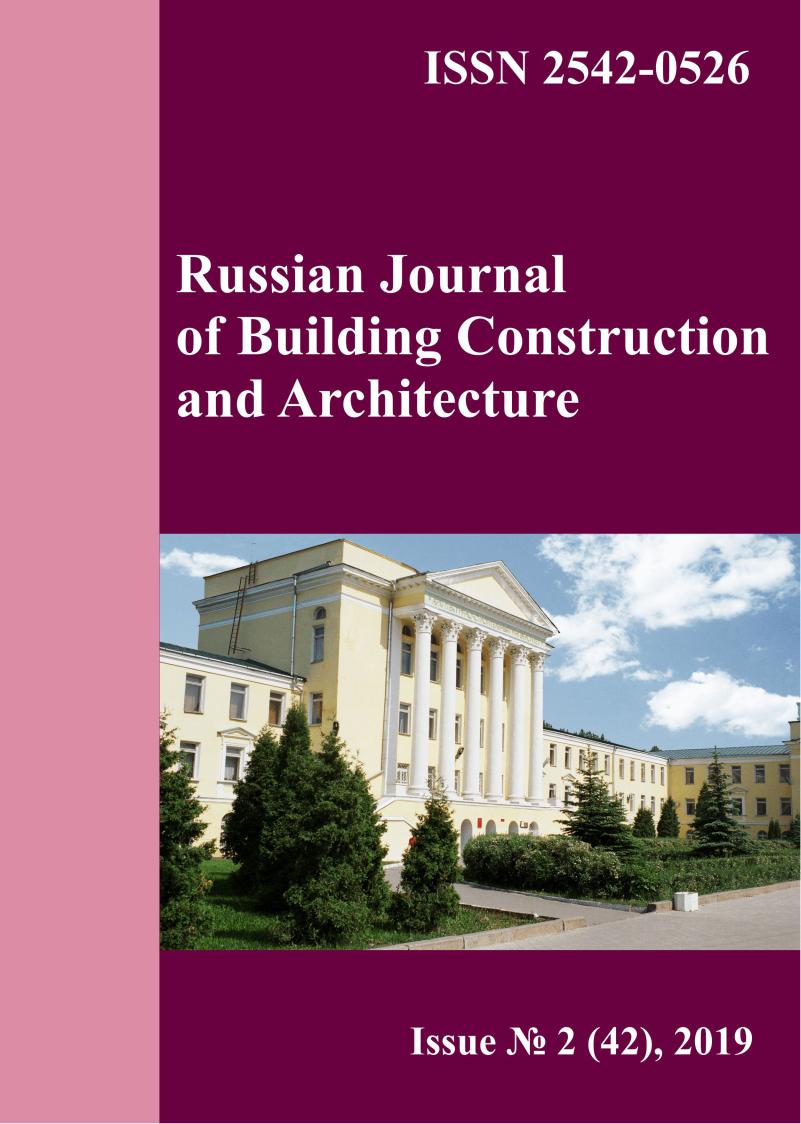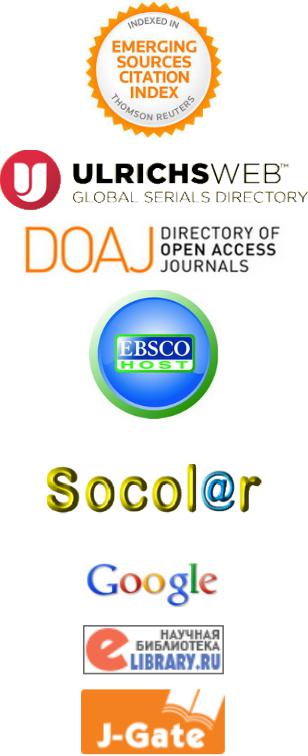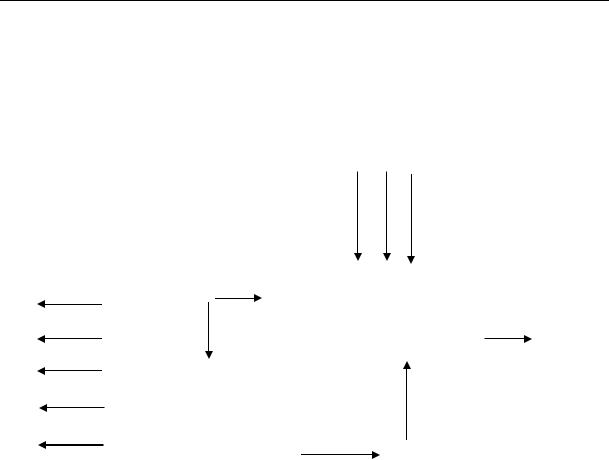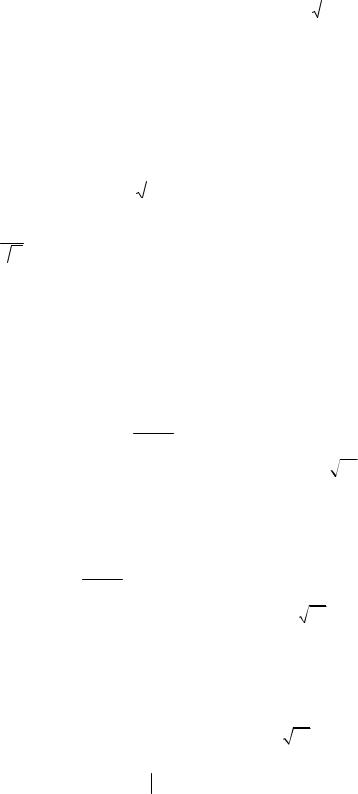
Russian Journal of Building Construction and Architecture
.pdf
RUSSIAN JOURNAL
OF BUILDING
CONSTRUCTION AND ARCHITECTURE
1

The journal is indexed/abstracted in:
Web of Science Core Collection
(Emerging Sources Citation
Index)
(Thomson Reuters), USA
Ulrich's Periodicals Directory
(Bowker), USA,
DOAJ
(Lund University), Sweden,
Academic Search Complete
(EBSCO), USA,
SOCOLAR
(China Educational Publications Im-
port and Export Corporation ––
CEPIEC), China,
Google Scholar
(Google), USA,
E-Library
(ООО «РУНЭБ»), Russia,
J-Gate
(Informatics Ltd), India
2
ISSN 2542-0526
RUSSIAN JOURNAL
OF BUILDING
CONSTRUCTION AND ARCHITECTURE
N 2 (42)
BUILDING STRUCTURES, BUILDINGS AND CONSTRUCTIONS
BASES AND FOUNDATIONS, UNDERGROUND STRUCTURES
HEAT AND GAS SUPPLY, VENTILATION, AIR CONDITIONING, GAS SUPPLY AND ILLUMINATION
BUILDING MATERIALS AND PRODUCTS
TECHNOLOGY AND ORGANIZATION OF CONSTRUCTION
DESIGNING AND CONSTRUCTION OF ROADS, SUBWAYS, AIRFIELDS, BRIDGES AND TRANSPORT TUNNELS
BUILDING MECHANICS
THEORY AND HISTORY OF ARCHITECTURE, RESTORATION AND RECONSTRUCTION OF HISTORICAL
AND ARCHITECTURAL HERITAGE
ARCHITECTURE OF BUILDINGS AND STRUCTURES. CREATIVE CONCEPTIONS OF ARCHITECTURAL ACTIVITY
CITY PLANNING, PLANNING OF VILLAGE SETTLEMENTS
Voronezh 2019
3

Russian Journal
of Building Construction and Architecture
Periodical scientific edition
Published since 2009 |
Comes out 4 times per annum |
|
|
|
|
|
|
Founder and publisher: Federal State Education Budget Institution of Higher Professional Education «Voronezh State Technical University».
The articles are reviewed and processed with the program ANTIPLAGIARISM. This publication cannot be reprinted without the prior permission of the publisher, references are obligatory.
Number of the certificate of registration of the media ПИ №ФС 77-67855 Issued bythe Federal Service for Supervision of Communications, Information Technology,
and Mass Media (Roskomnadzor)
Price is subject tochange
EDITORIAL COUNCIL
The Head of the Council: Kolodyazhny S. A., D. Sc. in Engineering, rector (Voronezh State Technical University)
EDITORIAL BOARD
Editor-in-Chief: Melkumov V. N., D. Sc. in Engineering, Prof.
(Voronezh State Technical University)
Members:
Boldyrev А.М., Corresponding Member of the Russian Academy of Architecture and Engineering Science, D.Sc. in Engineering, Prof., Voronezh State Technical University, Russia
Bondarev B. А., D. Sc. in Engineering, Prof., Lipetsk State Technical University, Russia
Gagarin V. G., Corresponding Member ofRAABS, Moscow State University ofCivil Engineering, Russia
Gelfond А. L., Corresponding Member of the Russian Academy of Architecture and Construction Science, D. Sc. in Architecture, Nizhniy Novgorod State University of Architecture and Construction, Russia
Enin A. Ye., PhD in Architecture, Prof., Voronezh State Technical University, Russia
Karpenko N. I., Academician of RAABS, Research Institute of Building Physics (NIISF RAABS), Russia
Kirsanov М.N., D.Sc. in Physics and Mathemat-
ics, Professor (National Research University “Moscow Power Engineering Institute”)
Kobelev N. S., D. Sc. in Engineering, Prof., Southwest State University, Kursk, Russia
Kolchunov V. I., Academician of RAABS, Southwest State University, Kursk, Russia
Ledenyev V. I., D. Sc. in Engineering, Prof., Tambov State Technical University, Russia
Lyahovich L. S., Academician ofRAABS, Tomsk State University of Architecture and Building, Russia
Mailyan L. R., D. Sc. in Engineering, Prof., Don State Technical University, Rostov, Russia
Panibratov Yu. P., Academician of RAABS, Saint Petersburg State University of Architecture and Civil Engineering, Russia
Podolsky Vl.P.,D. Sc. in Engineering, Prof., Voronezh State Technical University, Russia (Dep. of the Editor-in-Chief)
Slavinskaya G.V.,D. Sc. in Chemistry, Prof, Voronezh State Technical University, Russia
Suleymanov А.М.,D. Sc. in Engineering, Prof., Kazan State University of Architecture and Engineering, Russia
Fyedorov V. S., Academician of RAABS, Moscow State University of Railway Engineering, Russia
Fedosov S. V., Academician of RAABS, Ivanovo State Polytechnic University, Russia
Chernyshov Ye. M., Academician of RAABS, Voronezh State Technical University, Russia
Shapiro D. M., D. Sc. in Engineering, Prof., Voronezh State Technical University, Russia
Shubenkov М. V., Academician ofthe Russian Academy of Architecture and Construction Science, D. Sc. in Architecture, Prof., Моscow Institute of Architecture (State Academy), Russia Asanowicz Alexander, Prof., Dr. of Sn., Technical University of Bialystok, Poland
Figovsky Oleg L., Prof., Dr. of Sn., Member of EAS, Israel Korsun V. I., D. Sc. in Engineering, Prof., The Donbas National Academy ofCivil Engineering and Architecture, Ukraine Nguyen Van Thinh, Prof., Dr. of Sn., Hanoi University of Architecture, Vietnam
Editor: Kotlyarova E. S. |
Translator: Litvinova O. A. |
THE ADDRESS of EDITORIAL AND THE PUBLISHER OFFICE:84 20-letiya Oktyabrya str., Voronezh, 394006, Russian Federation Tel./fax: (473)2-774-006; e-mail: vestnik_vgasu@mail.ru
Publication date 15.05.2019. Format 60×84 1/8. Conventional printed sheets 12. Circulation 500 copies. Order 87 .
Published in Printing Office of Voronezh State Technical University 84 20-letiya Oktyabrya str., Voronezh, 394006, Russian Federation
ISSN 2542-0526 |
© Voronezh State Technical |
|
University, 2019 |
4
CONTENTS |
|
HEAT AND GAS SUPPLY, VENTILATION, AIR CONDITIONING, |
|
GAS SUPPLY AND ILLUMINATION........................................................................................... |
6 |
Gulevskii V. A., Osipov Ye. N., Shatskii V. P. |
|
Cooling of Technical Objects Using Evaporation Coolers ...................................................... |
6 |
Kumitskii B. М., Savrasova N. А., Sedaev А. А. |
|
Mathematical Modeling of Thermal Process in Freezing (Thawing) of Wet Soil .................. |
16 |
Ryabenko А. S., Kuznetsov S. N. |
|
Determining the Temperature in a Semiplane with a Slant Linear Crack Reaching |
|
the Half Plane Boundary....................................................................................................... |
25 |
DESIGNING AND CONSTRUCTION OF ROADS,SUBWAYS, AIRFIELDS, |
|
BRIDGES AND TRANSPORT TUNNELS.................................................................................... |
34 |
Kozlov V. A., Kotov A. I., Loboda A. V. |
|
Modelling Failures of Asphalt Concrete Surfacings Caused |
|
by a Dynamic Impact of Water............................................................................................. |
34 |
Medvedev V. A., Burkovskii V. L., Trubetskoi V. A., Mukonin A. K. |
|
The Robot with the Angular Coordinate System for Installation of Sleepers in the Metro..... |
43 |
Samodurova Т. V., Volkov V. V., Sklyarov K. A. |
|
Modelling the Bearing Properties of a Road Structure Restored Using Interlayer Injection |
|
by Means of a Repairing Solution......................................................................................... |
53 |
BUILDING MECHANICS ........................................................................................................ |
62 |
Kirsanov M. N. |
|
Calculation of G-shaped Farming of Road Signs and Equipment.......................................... |
62 |
CITY PLANNING, PLANNING OF VILLAGE SETTLEMENTS .................................................... |
72 |
Dopudja D., Rakonjac I., Gadzic N. |
|
Peculiar Properties and Possible Ways of Improvement of Current Fourfold Village |
|
Settlements Classifications in Republic of Serbia.................................................................. |
72 |
Mel'kumov V. N., Kuznetsov S. N., Tul'skaya S. G., Chuikina A. A. |
|
Influence of the Layout of Functional Zones of Cities on the Development |
|
of Heat Supply Systems........................................................................................................ |
85 |
Sotnikova O. A., Shchetinin N. V. |
|
Modelling of the Distribution of Thermal and Contaminant Pollutions |
|
in a Ground Layer of Urban Streets...................................................................................... |
93 |
INSTRUCTIONS TO AUTHORS.............................................................................................. |
102 |
5

HEAT AND GAS SUPPLY, VENTILATION, AIR CONDITIONING,
GAS SUPPLY AND ILLUMINATION
DOI 10.25987/VSTU.2019.42.2.001
UDC 697.9
V. A. Gulevskii1, Ye. N. Osipov2, V. P. Shatskii3
COOLING OF TECHNICAL OBJECTS USING EVAPORATION COOLERS
Voronezh State Agricultural University
Russia, Voronezh, tel: (473)29-103-39, e-mail: sha.vladim@yandex.ru
1D. Sc. in Engineering, Prof. of the Dept. of Mathematics and Physics
2PhD student of the Dept. of Mathematics and Physics
3D. Sc. in Engineering, Head of the Dept. of Mathematics and Physics
Statement of the problem. The problem of air cooling of technical objects by means of evaporative recuperative coolers is considered.
Results. The equation of an unsteady thermal balance of limited volume with technological equipment is derived taking into account its cooling by recuperative water-evaporative coolers. The mathematical model of thermal and physical processes in indirect evaporative recuperative air coolers and the method of its implementation are presented. The model contains partial differential equations describing the energyand mass transfer in the channels of the heat exchange unit.
Conclusions. As a result of the research, it was established that installing indirect evaporative recuperative cooling of type will allow one without increasing the humiditylevel of the air yto considerablyreduce the temperature in facilities with technological equipment emitting a great deal of heat. Environmental friendliness and cost effectiveness of cooling units of this type add to the positive effects theyoffer.
Keywords: evaporative coolers, mathematical modeling, heat balance, industrial facility.
Introduction. The lack of energy resources and impending environmental pollution are paving the way for sustainable energy technologies and renewable energy sources. One of the areas of technology that is currently in demand is reducing the air temperature of facilities equipped with large air emission sources. Ventilation systems of traction substations, engine rooms of metropolitan stations do not warrant a proper temperature due to a lot of incoming air from the equipment and limited volumes of supplied air. In this case heat can only be utilized provided that a variety of air conditioning setups is employed.
© Gulevskii V. A., Osipov Ye. N., Shatskii V. P., 2019
6
Issue № 2 (42), 2019 |
ISSN 2542-0526 |
Water vapour coolers that have been in use over the recent decades have proved to be reliable, high-performance and environmentally friendly. Among other things, cooling commonly involves high humidity levels of the incoming air, which is not permissible in metro stations. Therefore designing indirect recuperative water vapour coolers that are capable of air cooling with no changes in its humidity level is an important issue.
1.Choosing the air cooling method. Compressor systems using freon or substitutes are not particularly energy-saving and most importantly, they not only produce cold but also emit a great deal of heat that might be challenging to deflect in small spaces. Therefore using air-cooling equipment that doesnot contribute to higher humidity levels seems more appropriate to use.
The principle of the operation of indirect recuperative vapour is as follows. A common air flux is fed not into layers not coming into contact with water “dry” channel s where this flux is split into the “main” one coming into the facility and the “auxiliary” one that is in the opposite direction and coming into alternating “dry” and “wet” channel s where water is evaporated off capillary and porous surfaces splitting the channel s of plates. This moist air cools down the “main” air flux by means of heat transfer and is deflected beyond the facility.
The major advantages of the setups are the following: –– World-class environmental safety;
–– Comfort and safety of the output air in terms of flu and cold bugs;
–– Use ofthe block method which makesdesign, assemblyand maintenanceconsiderablyeasier; –– Easy-to-use operation, no special equipment or materials required;
–– 3––5 times energy savings;
–– Self-regulation effect (depending on the air parameters), which makes the system a lot easier to use and saves automatization costs.
Starting fromthe late 2007 air coolersАОВ-5000 [1] have been in operation in the transformation stations (TS) of the Moscow metro system. They are particularly designed for temperature of the channel. Their cooling principle entails the main air flux fed into a special collector below the transformers which then passes through them taking off their heat. The auxiliary air flux is deflected from the TS into the tunnel through air deflectors. Owing to the scheme and high performance ofthe coolersthe temperature inthe TS wasreduced from380Сdownto 270С.
2.Modelling a heat balance and physical processes in indirect recuperative water vapours. In order to identify operating modes of coolers, it is necessary that we carry out mathematical modeling of heat balance of in the cooling facility with consideration of the above cooling system.
7

Russian Journal of Building Construction and Architecture
Let the initial temperatures of the enclosures of the premises be T0 = const. At the time moment t = 0 its surface starts washing a gaseous surface with the temperature T(τ). Heat ex change between the environment and a semi-infinite surface of the enclosures complies with the Newton law (the third-order boundary condition). Let us look at the heat balance in the cooling facility (Fig. 1).
|
|
|
Tn |
|
|
|
|
|
|
|
|
Ginf |
|
|
|
|
|
|
Q |
|
|
Gm mm |
|
q |
|
|
|
Gs |
Tk |
|
|
|
|
|
|
|
|
||
|
|
T |
G |
|
|
|
|
|
|
|
|
|
|
||
|
|
|
|
|
|
|
|
|
|
|
|
|
|
|
|
|
|
|
|
|
|
|
|
Fig. 1. For identifying the heat balance equation.
Q are heat emissions of the equipment, q is the heat flux through the enclosures, G is the total air flux of the temperature T at the cooler input, Gm = Ginf are the fluxes of the “wet” air and infiltration air
ofthetemperatureТn,Gs andТk istheconsumption andtemperatureofthe“dry” airatthecooler outputrespectively
Over the time change in the energy V is given by the formula:
Q1 C V T T .
The energy Q comes from the equipment. Due to the general air flux coming into the cool-
er the energy Q2 |
C GT( ) is removed into the cooler where G, ρ, С are the general air |
|||
flux, |
m3/seс, air |
density, kg/m3 and specific heat capacity, J/kg/degree. The energy |
||
Q3 |
C GkTk comes from the main air flux of the cooler where Gk, Tk are the main air |
|||
flux, |
m3/seс and |
its temperature respectively. Due to infiltration there |
is |
the energy |
Q4 |
C GinfTn coming where Tn is the temperature of the outside air, Ginf |
=Gm |
is the con- |
|
sumption of the auxiliary air flux.
8

Issue № 2 (42), 2019 |
ISSN 2542-0526 |
There is heat exchange through the walls with the energy Q5 q Fogr where q is the density of the heat flux [2, 8, 9, 15]:
q T( ) T eH2a erfc(H |
a |
), |
|
0 |
|
|
|
H = / is a relative heat exchange coefficient, 1/m, |
5,6 4 u , Watt/(m2/degrees) where |
||
u is the speed of the blown air, m/seс, λ is the coefficient of the heat conchannel ivity of the
enclosure, Watt/m/degrees), a=λ/(Cρ) is the coefficient of the heat conductivity, m2/seс, |
Fogr |
||||||
is the area of the enclosing surface, m2. |
|
|
|||||
|
|
2 |
|
|
|
|
|
Here |
erfc(x) 1 erf(x) |
|
e z2dz |
is an extra probability integral |
and |
||
|
|
|
|||||
|
|||||||
|
|
|
x |
|
|
||
x
erf(x) 2 e 2d is the Gauss error function, or a probability integral.
 0
0
The equation of heat balance is as follows:
Q1 Q Q2 Q3 Q4 Q5 .
Inserting the previous ratios into the last equation and moving on to the range at 0, weget:
C V dT( ) Q C GT( ) C GkTk ( ) C GinfTn d
T( ) T0 eH2a erfc(H
 a )Fogr.
a )Fogr.
Let us denote as k the ratio of the main air flux Gk to the auxiliary one Gm. Then G= Gm + + Gk = (k+1) Gm and
C V dT( ) Q C (k 1) GmT( ) C Gm (kTk ( ) Tn ) d
T T0 eH2a erfc(H
 a ) Fogr.
a ) Fogr.
or
V |
dT( ) |
Q/C (k 1) G T( ) G (kT ( ) T ) |
||
|
||||
|
d |
m |
m k |
n |
|
|
|
(1) |
|
T T0 eH2a erfc(H
 a ) Fogr /C .
a ) Fogr /C .
Adding the original condition: T 0 Tнач , we get the Koshi task for determining the dependence of the air temperature in the facility on the time.
9
